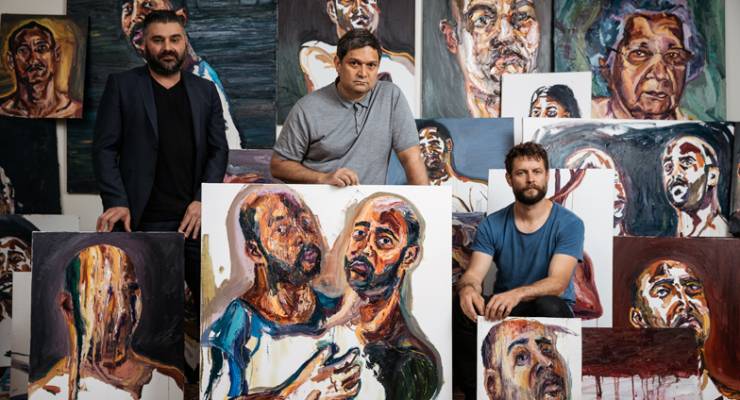
(L-R) Campbelltown Arts Centre director Michael Dagostino, Sydney Festival director Wesley Enoch and Australian artist and exhibition curator Ben Quilty. Source: AAP
The title for the first major exhibition of art works by Myuran Sukumaran, Another Day in Paradise, came directly from the executed drug smuggler himself.
Those words appeared in a subject line of an email sent to artist and Sukumaran’s mentor Ben Quilty, following a particularly violent riot at Bali’s Kerobokan Prison.
For the last four years of Sukumaran’s life, he ran an art studio within the prison and taught lessons to his fellow inmates. Sukumaran had access to the prison’s medical facility so that he could test participants for drugs (if there were drugs found within the art studio it would be shut down), which meant that when the riot broke out it was he who had to help.
“There was a machete wound to a man’s leg,” Quilty said. “He sent me these very grainy iPhone photos of him sewing up a man’s leg, and there was just blood everywhere, and the email subject line was ‘another day in paradise’.”
Now, almost two years after Sukumaran’s death, Quilty is opening the exhibition, featuring more than 100 of Sukumaran’s works completed in prison, alongside pieces commissioned from other artists (Abdul-Rahman Abdullah, Megan Cope, Jagath Dheerasekara, Taloi Havini, Khaled Sabsabi and Matthew Sleeth).
Quilty co-curated the exhibition with Michael Dagostino, the director of Campbelltown Arts Centre, where the show opens this weekend as part of Sydney Festival. Dagostino says he was compelled to host the exhibition in Campbelltown given that Sukumaran grew up in western Sydney, where his family still lives.

Source: document photography (supplied by Campbelltown Arts Centre)
“Myuran’s story is a western Sydney story, one of redemption through immense adversity,” he said.
But it’s still a rather gutsy move on the part of both Sydney Festival and Campbelltown Arts Centre to exhibit the works of such a controversial figure.
Although there was plenty of support in Australia for Sukumaran and his fellow executed Bali Nine member Andrew Chan (who features in the exhibition), the community was clearly divided. A poll held three months before Sukumaran’s execution asking “if an Australian is convicted of drug trafficking in another country and sentenced to death, should the penalty be carried out?” received a 52% affirmative response from Australians.
“There are still a lot of haters in the community,” Quilty said. “And I invite them all with very open arms to come along to this exhibition, and I challenge them to walk away from this exhibition filled with the same hatred towards my mate as they had in the lead-up to his execution.”
Sukumaran became a prolific painter in his final years within the prison, and the exhibition features plenty of never-before-seen works, and a wall of paintings made during his last 72 hours of life.
One of the works from those final hours sits on the floor, against the wall. Dagostino says that it symbolises Sukumaran’s unfinished business.
While the exhibition features less than half of Sukumaran’s total output, it includes key works known to the public, including his final painting: an Indonesian flag realised with thick red paint, seeming to bleed. The back of the canvas was signed by all nine prisoners facing execution that day.
Quilty believes that Sukumaran was only just starting to find his own “unique visual language” when he was executed, but that the exhibition demonstrates something quite profound.
“I hope that this show goes a long way to showing not only the healing quality of what an art practice can do, but how much a visual language can change and alter the world, and make people think in a different way,” he said.
When Quilty first came into contact with Sukumaran, he gave him a pile of art books to help him refine his painting skills. He says he’s never seen somebody develop their craft at such speed.

Source: document photography (supplied by Campbelltown Arts Centre)
“Myuran was the first person to read those art books from beginning to end. I only looked at the pictures. He read every single word in every art book that I gave him,” Quilty said.
He also advised Sukumaran to turn the mirror on himself, because he was the most interesting subject that he had. One large wall in the exhibition features 36 self-portraits, all grappling with different ways of looking at oneself.
But his subjects also include his fellow inmates, all of the Bali Nine, his close friends and family members, and even the Australian and Indonesian politicians involved in the diplomatic negotiations concerning his case.
What seems clear is that the exhibition will have a great emotional impact on many who visit, no matter where they stand on the death penalty and the Bali Nine case.
But Quilty says this is a brave and courageous starting point for Sukumaran’s artistic legacy.
“If Myuran only knew that this show was here, with these six extraordinary artists responding … I promised him that this would happen, but to know that it’s happened on this scale …”
*This article was originally published at Daily Review







Crikey is committed to hosting lively discussions. Help us keep the conversation useful, interesting and welcoming. We aim to publish comments quickly in the interest of promoting robust conversation, but we’re a small team and we deploy filters to protect against legal risk. Occasionally your comment may be held up while we review, but we’re working as fast as we can to keep the conversation rolling.
The Crikey comment section is members-only content. Please subscribe to leave a comment.
The Crikey comment section is members-only content. Please login to leave a comment.